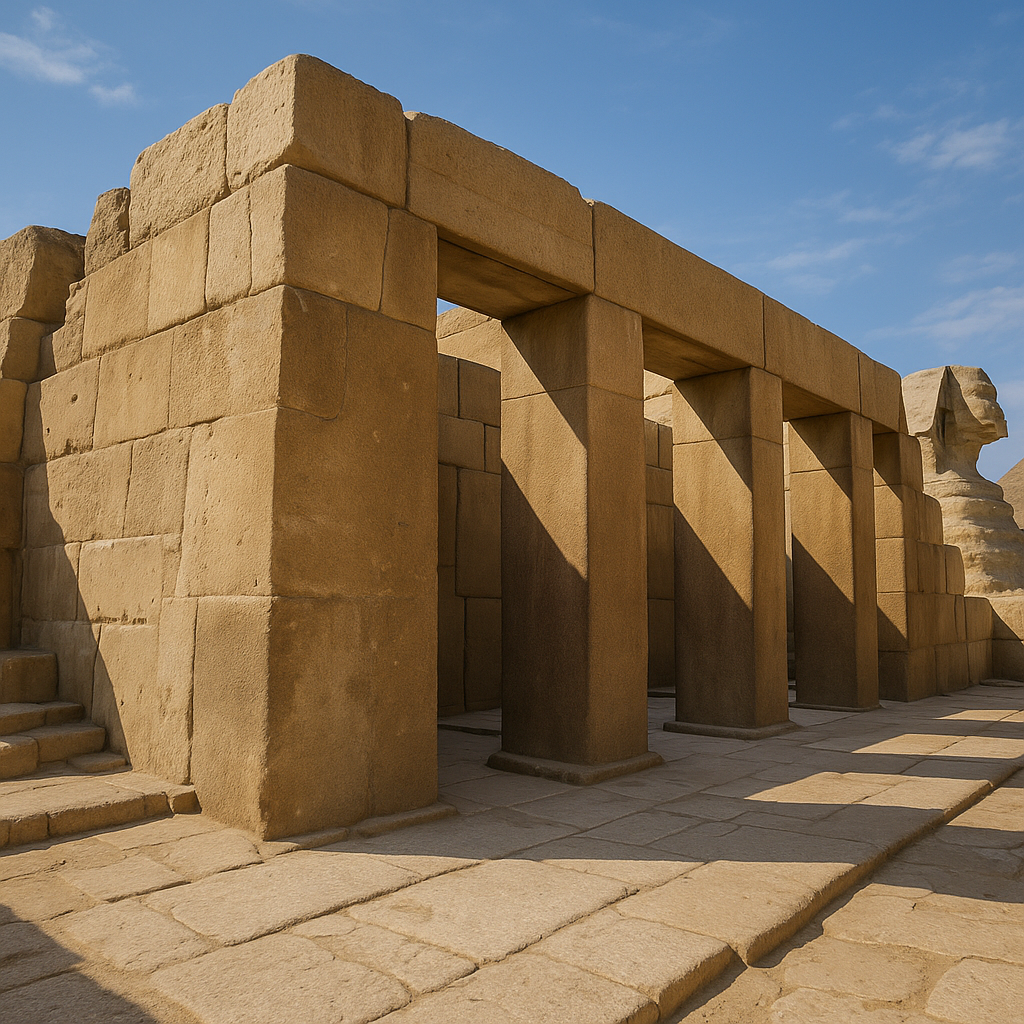Introduction to the Valley Temple
The Valley Temple stands as one of the most significant monuments in the Giza Plateau, offering profound insights into ancient Egyptian religious practices and architectural mastery. Built during the reign of Pharaoh Khafre in the Old Kingdom (around 2570 BC), this temple functioned as part of the pyramid complex, directly connected to the Pyramid of Khafre and the Great Sphinx.
Unlike the grandeur of the pyramids towering above, the Valley Temple lies close to the Nile, serving as the ceremonial entrance to the mortuary complex. Here, mummification rituals, purification rites, and offerings for the deceased pharaoh were performed. The temple’s limestone walls, red granite pillars, and polished alabaster floors showcase a sophistication that continues to amaze archaeologists.
For travelers exploring Giza, the Valley Temple isn’t just another ruin—it’s a gateway into the spiritual heart of Egypt’s pyramid age.
The Historical Role of the Valley Temple
The Valley Temple of Khafre was not a standalone structure but an essential part of the pyramid complex. It connected to the Nile through a long causeway, allowing boats to deliver the pharaoh’s body after death. From here, priests conducted purification ceremonies before transferring the body to the mortuary temple near the pyramid for final burial rituals.
Historians believe the temple also hosted the “Opening of the Mouth” ceremony—a sacred rite believed to restore the senses of the deceased, enabling them to eat, drink, and speak in the afterlife. This emphasizes the temple’s dual function: both practical in preparing the body and spiritual in ensuring eternal life.
Architectural Features of the Valley Temple
Monumental Construction
The Valley Temple is built from megalithic limestone blocks, some weighing more than 200 tons. Granite imported from Aswan was used for its massive pillars, while alabaster decorated the floors, giving the temple a majestic yet austere appearance.
Interior Layout
The temple’s design is simple yet symbolic. It features T-shaped halls, multiple chambers, and an inner sanctuary. Two rows of massive granite pillars divide the main hall, creating a solemn atmosphere befitting sacred rituals. The polished surfaces and geometric precision reflect the architectural genius of ancient Egypt.
The Colossi of Khafre
Statues of Pharaoh Khafre, carved from diorite, were originally placed within the temple. One of the most famous, depicting the king seated with the falcon god Horus protecting his head, was discovered here and now resides in the Egyptian Museum in Cairo.
Religious and Cultural Significance
The Valley Temple wasn’t just a ceremonial hall—it was a bridge between life and eternity. Every detail, from its alignment with the Sphinx to its proximity to the Nile, symbolized renewal, rebirth, and divine connection.
Ancient Egyptians believed that by performing rituals in this sacred place, they ensured the pharaoh’s successful journey into the afterlife. In turn, the well-being of Egypt depended on the eternal presence of their divine ruler.
The Valley Temple and the Great Sphinx
One of the most fascinating aspects of the Valley Temple is its close association with the Great Sphinx. The temple sits directly in front of the Sphinx, and many scholars argue that the two structures were designed as a unified spiritual complex. This alignment suggests that the Valley Temple may have also been dedicated to solar worship, linking the pharaoh’s divinity with the sun god Ra.
Visiting the Valley Temple Today
What to Expect
Travelers visiting Giza can easily access the Valley Temple alongside the Sphinx enclosure. While its roof is no longer intact, the massive stone blocks and inner chambers remain remarkably well-preserved. Visitors often marvel at the sheer size of its limestone blocks and the precision of its construction.
Best Time to Visit
Early mornings and late afternoons are ideal times to explore, when the sunlight creates dramatic shadows across the temple walls. Pairing your visit with the nearby Sphinx and Pyramids makes for an unforgettable day in Giza.
Practical Travel Tips for the Valley Temple
- Location: Giza Plateau, adjacent to the Great Sphinx.
- Entry: Included with most Giza Plateau tickets.
- Duration: Spend 30–45 minutes exploring before continuing to the Sphinx and pyramids.
- Guides: Hiring a local Egyptologist guide enriches the experience with detailed history and hidden stories.
- Photography: Best lighting is during golden hour, when the temple stones glow with warm tones.
Why the Valley Temple is a Must-See in Giza
The Valley Temple is more than an archaeological wonder—it’s a sacred reminder of Egypt’s fascination with eternity. While the pyramids dominate the skyline, the Valley Temple reveals the rituals and beliefs that gave meaning to these monumental tombs. For those who want to understand the spiritual essence of ancient Egypt, no visit to Giza is complete without stepping into this timeless sanctuary.
FAQs About the Valley Temple
Q1: Who built the Valley Temple in Giza?
It was constructed during the reign of Pharaoh Khafre in the Old Kingdom, around 2570 BC.
Q2: What was the Valley Temple used for?
The temple was used for mummification, purification rituals, and the “Opening of the Mouth” ceremony before the pharaoh’s burial.
Q3: Where is the Valley Temple located?
It sits beside the Great Sphinx at the Giza Plateau, forming part of Khafre’s pyramid complex.
Q4: Can tourists visit the Valley Temple?
Yes, it’s accessible with general Giza Plateau tickets and is often included in guided tours.
Q5: What materials were used to build the Valley Temple?
The temple was constructed with limestone, red granite from Aswan, and alabaster for its floors.
Q6: How does the Valley Temple connect to the Sphinx?
The temple and the Sphinx are aligned, suggesting they formed part of a unified religious and solar worship complex.

Comment (0)